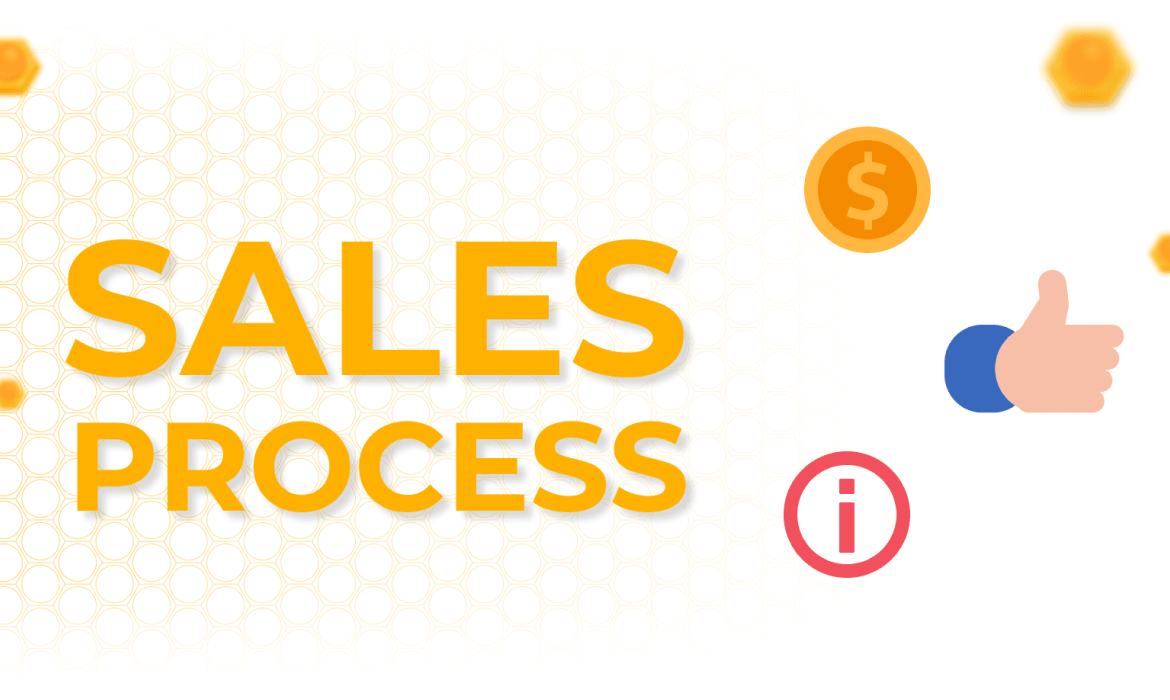Thanks to Larry Page and Sergey Brin, we can google the information that we are too shy to ask. And this article is exactly for the guys like that. If you want to know more about a sales process but don’t want to ask uncomfortable questions, read on!
What is a sales process?
Let’s go back to basics for a moment. You probably have two major questions: what is a sales process and why do you need it in the first place?
A sales process is a combination of steps, individual for every company, with the purpose of converting a lead into a client.
If you find this sales process definition too generic, hold on: the devil is in details. When you start assessing small pieces of a big puzzle, you finally get the idea of the full scope of work. But don’t worry, our guide will help you create an effective sales process or optimize the existing one.
Sales Process vs. Sales Methodology
Before we move to the key steps of a sales process, let’s deal with one common confusion. I’m talking about the notions of a sales process and methodology, which are often mistaken even by the professionals.
A sales process is a combination of stages and activities that your sales reps conduct to win the customer. This is your working plan, a “how to” for turning opportunities into deals.
Meanwhile, sales methodology is rather an approach to sales, which includes your goals and strategy. For instance, you may focus all your sales activities on customer needs, and this will be your sales methodology. Or you may want to challenge your prospects with several options and close deals this way.
Before building a sales process, do research and find a sales methodology that you’d like to follow. It should correspond to your current priorities, the type of the company, its size, and target audience.
What are the common steps in a sales process?
As soon as you understand which way you want to go, you may start building your own sales process. In most successful companies it consists of 7 main stages, which are further divided into smaller steps.
Prospecting
When creating a sales process, you usually start with lead generation and prospecting. There are so many ways to do it that anyone may find something suitable. For instance, you may rely on cold calling techniques, cooperate with a marketing team, or make use of networking.
The thing is you have to adjust your prospecting tactics depending on the market segments you work with. I mean, it is not such a good idea to use cold calls when you are seeking prospects in the Government or Banking industry. In such a case, making use of your network or direct emails will be much more efficient.
Preparation
We may easily divide this step into two tasks: 1) polish your knowledge of the service/product you want to sell and 2) get more information on the prospect.
The first one may seem quite easy and straightforward if understood correctly. Unfortunately, some sales managers tend to forget how little their prospects know about the product. Thus, they start loading potential clients with unnecessary technical details, omitting basic information. However, customers may have no idea of the simplest product features or the applied technology.
That is why always try to put yourself in the shoes of the prospect. Find out more about their pains and needs and show them which way you may help the situation. This way you’ll be able to make a topical offer and build stronger customer relationships.
Approach
Basic sales process steps include finding the right approach to the specific prospect. There are some general rules that your team may follow in order to boost engagement and improve performance.
- Adjust your approach to a specific audience. You got to admit that banking industry and IT startups require absolutely different types of interaction. Thus, your tone of voice, means of communication, and even the tools and software may vary on a case-by-case basis.
- Always listen to the prospect when discussing their needs and desires. Pay attention to the smallest details and use them to mutual advantage. 78% of sales reps admit that listening has a great impact on converting a prospect into a client. So listen to your prospects, understand what way they want to go and provide the best possible solution.
- Take detailed notes during the conversation. You cannot fully rely on your memory when it comes to closing deals. For that reason, we recommend you to write down key takeaways of all calls and meetings. This way you’ll be able to analyze this information later and come up with an idea of your final offer.
Presentation
Before sending your proposal, assess customer needs to find out what kind of offer they won’t be able to resist. Do the research, ask questions, and analyze!
When it comes to the presentation itself, make sure to show your expertise. 78% of B2B customers are looking for salespeople who act like trusted advisors. Build rapport and show them the way to achieve what they want. As soon as your prospects feel that you know how to help, you will reach the point of consensus.
Please note that your presentation should rather focus on solving client’s problems and not on explaining your product benefits. This way you’ll have higher chances of winning the client and closing the deal.
Handling objections
Here comes one of the final steps of the sales process – handling disagreements. If you think that your prospects are the nicest people you’ve ever met, think twice. The thing is ALL clients have some objections and you’ll need to take care of them.
First, when facing an objection, keep calm and take a long pause to make up your mind on what you’re going to reply. And don’t be in a hurry: control your pace and tone of voice.
Besides, it’s a good idea to ask questions. Top sales performers counter client objections with questions 23% more often than their less successful colleagues. So don’t be shy! Ask your prospect why they have such an objection and how you may reach consensus.
But most importantly don’t try to cover it all by producing a long monologue. Remember that any conversation is a two-sided process and not a one-man show. Overall, ask questions, give well-considered answers, and maintain the flow of the conversation.
Closing
Have you ever heard that most sales reps give up after the fourth follow-up, while 80% of prospects say “yes” only after the fifth one? Well, now it’s no wonder why so many salespeople fail to close a deal. The question is how should you do it?
First, make sure all of your sales process stages lead a prospect to the purchase. Yet, this may involve different goals for each point. For instance, when you are at an early stage, or even making the first contact, your may aim to schedule a call with the client or have a one-to-one meeting.
Besides, you should end every conversation with an agreement on the next step of your collaboration. If you go out of a meeting with the answer “we’ll get back to you later”, I might have bad news for you…
Following Up
Closing a deal should never become the final step of a sales process. Why do you limit yourself with only one deal when you can close more? For that reason, you should always follow up on a client after they complete the purchase.
Here’s a couple of worthy ideas for such follow-ups:
- Share valuable information with a client (a relevant article, an FAQ, a video guide to the product).
- Check if the client is satisfied with the quality of the product or service you provide.
- Reply to client’s news, congratulate them on some occasion or achievement.
- Invite them to the upcoming events, such as conferences or meet-ups.
- Ask your customer for feedback or referrals.
In a nutshell, take care of the customer experience and you’ll increase your returning customer rate.
Watch: How to Write Follow Up Emails [Tips & Templates]
Sales process example
As an example of an efficient sales process, let’s take an existing B2B tech startup. Here’s a funnel they created.
- Get the lead.
- Find the key decision maker, their contact information, some personal details.
- Send the quotation and follow-up emails as long as needed.
- Schedule a call with the decision maker, during which persuade them to try a free demo of the product. Handle all objections and negotiations.
- During the trial period, contact the prospect regularly (once a week or as often as needed).
- At the end of the trial period, have a call with the prospect. Close the deal. If necessary, offer a discount or extra services.
- Sell additional bonus features or a dedicated customer support manager.
- Approve the purchase, sign the contract, deliver the product.
- Follow up and make sure the product is working well with the client.
- Follow up for referrals, reviews, and feedback.
How to build a sales process
Now that you know what a sales process looks like, let’s try to figure out how to build one.
1. Organize data
At present, most sales teams conduct data analysis to prioritize leads, trying to no rely solely on intuition. That’s why you’ll need to organize all the customer data you have and analyze it regularly. It is essential to keep the information in order to track the progress and foresee the next step. The thing that will help you do that is a suitable CRM software.
To choose a CRM that fits your company, consider your main purpose and get enough feedback from the team. For instance, if your sales reps use Gmail on a daily basis, you should focus on Gmail based systems. One of such CRMs in NetHunt. It allows your salespeople to close the deal right in their inbox, not switching between different tabs. Besides, it is quite easy to use and doesn’t require any additional training.
2. Create selling stages
As soon as you put your data in order, you may start creating the whole sales process. Here, you have two options: 1) set new stages from scratch, or 2) observe your sales reps and adjust the stages to them.
Of course, your choice depends on the development of your company and your objectives. Yet, the previously mentioned stages may fit any company, regardless of the industry or the product.
3. Consider customer journey
Once you build the selling stages, you should test it on the real clients. Take a look at the customer journey and adjust your sales process to it. For example, your customers may require additional explanations or training as they start using the product. Or you may have extra services that you’d like to sell after your clients use the product for a while.
Work on the sales process continuously, try new approaches, and add stages until you find the most efficient scheme.
4. Establish a sales script
No matter if your sales reps are experienced professionals or just newbies, a sales script is an essential part of their workflow. Different scripts fit different situations and sales stages. Yet, there are some common recommendations that you should take into account when creating your individual sales script:
- Identify the pain points in the industry that your product/service resolves.
- Define some common needs of your potential customers.
- Develop the benefits or killing features of your product/service according to the pain points.
- Think through a consistent tone of voice that your sales team will stick to.
- Create a list of questions and possible objections your prospects may have.
5. Create a conversion funnel
Finally, set up a conversion funnel that will lead your prospect towards the purchase. Build your sales and marketing accordingly.
One of the most common conversion funnels is AIDA: Awareness, Interest, Desire, Action.
Sure thing, the sales process shouldn’t end up with a single purchase. Building a great customer experience, you re-engage existing clients and turn them into regular customers.
Watch: How to Manage Sales Pipeline in NetHunt CRM
Hopefully, we explained how to create a sales process, but your full cycle should also contain measurement and improvement. So read on!
How to measure a sales process
Сonstantly track your reps’ performance, measure results, and analyze the progress to improve your sales process. Metrics for measurement may vary depending on your goals, yet there are some key values that you may consider. They include:
- Lead to opportunity conversion rate.
- Opportunity to close conversion rate.
- The average amount of time spent on a prospect.
- Time spent on each of the stages in a sales process.
- The percentage of prospects that request a demo and the percentage of the ones who close after it.
- Deal won VS Deals lost ratio.
Keep in mind that you should constantly analyze your sales process to get the updated information and act accordingly.
Developing a sales process
Now it’s time to make necessary amendments to the existing workflow and start improving your sales process.
There are many ways to improve a sales process but they should be selected individually depending on the preceding data analysis. For instance, you may want to increase your sales cycle speed or re-evaluate one of the stages. Don’t forget to listen to your salespeople and clients, and you’ll do great!
Key takeaways
- Find the right sales methodology and build your sales process accordingly.
- When building a sales process, consider your company’s objections and the client journey.
- Focus on filling client needs and don’t just promote your product benefits.
- Listen more, talk less.
- Become a trusted advisor to each of the customers.
- Be ready to face objections. Don’t panic and rush, better address them with questions.
- Be persistent! Remember that most clients come to those who send five follow-ups.
- When building a sales process, start with organizing data – find a suitable CRM system.
- Measure and analyze your performance on a constant basis and adjust the sales process accordingly.
Table of Contents
Crack the sales formula with CRM Lab
Twice a month, receive actionable CRM content to your inbox.






